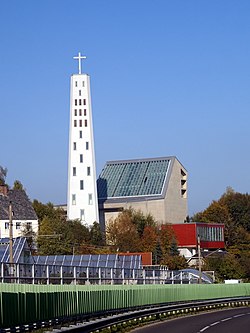Lenzing | |
|---|---|
 | |
| Coordinates: 47°58′34″N 13°35′44″E / 47.97611°N 13.59556°E | |
| Country | Austria |
| State | Upper Austria |
| District | Vöcklabruck |
| Government | |
| • Mayor | Rudolf Vogtenhuber (SPÖ) |
| Area | |
| • Total | 8.89 km2 (3.43 sq mi) |
| Elevation | 485 m (1,591 ft) |
| Population (14 June 2016)[1] | |
| • Total | 5,002 |
| • Density | 560/km2 (1,500/sq mi) |
| Time zone | UTC+1 (CET) |
| • Summer (DST) | UTC+2 (CEST) |
| Postal code | 4860 |
| Area code | 07672 |
| Vehicle registration | VB |
| Website | www.lenzing.ooe.gv.at |
Lenzing is a market town in the Vöcklabruck district of the Hausruckviertel in Upper Austria, with 5179 inhabitants. The responsible district court is in Vöcklabruck.
Geography
editLenzing lies at an altitude of 485 m in the Hausruckviertel. It extends 4.1 km from North to South and 4.2 km from East to West. The total area amounts to 8.9 km². The surface area is 12.4% wooded, and 56.2% is used for agriculture.
Parts of the municipality are: Alt Lenzing, Haid, Kraims, Neuhausen, Oberachmann, Pichlwang, Raudaschlmühle, Reibersdorf, Starzing, Thal, Ulrichsberg, Unterachmann.
Coat of Arms
editDivided by a silver wavy border diagonally right; above in red field a silver retort turned outward half filled with blue; below in a blue field a silver coniferous tree. The town colours are red-white-blue.
History
editOriginally lying in the Eastern part of Bavaria, the area around Lenzing has belonged to the duchy of Austria since the 12th century. Since 1490, it was added to the principality of 'Österreich ob der Enns'.
In 1892, the industrialist Emil Hamburger founded a paper factory in Pettighofen, the forerunner of the present day Lenzing AG.
Since 1918, the area belongs to the federal state of Upper Austria.
After the Anschluss in 1938, the "Zellwolle Lenzing AG" was founded (Zellwolle=Cellulose Wool). In 1939, the current municipality was formed with the addition of Oberachmann as well as some neighbouring municipalities.
In November 1944, a subcamp of the Mauthausen concentration camp was established in the Lenzinger suburb of Pettighofen. Up to 565 prisoners, mostly women, performed hard labour particularly at the Lenzinger Zellwolle AG. The camp was liberated at the beginning of May 1945 by the US Army.
Lenzing is a market town since 1984.
Politics
editThe mayor is Walter Franz Geisberger of the SPÖ. From the local council elections of 2003, the following mandate distribution resulted:
- SPÖ 23
- ÖVP 5
- FPÖ 3
Population development
editAccording to the various censuses, the municipality had 5063 inhabitants in 1991, 5049 inhabitants in 2001, and 5090 inhabitants in 2007.
Sport
editLenzing is the home of the ATSV Lenzing Modal.
Economics and Infrastructure
editLenzing is headquarters of Lenzing AG the world's largest integrated cellulose and viscose fiber producer with a cellulose production capacity of 225,000 per year. Additionally the town host a set of central and small industrial concerns.
Weblinks
edit- {{DORIS-Weblink|41713}}
References
editTranslation of the German article de:Lenzing (Oberösterreich) as retrieved 2009-09-10. {{Navigationsleiste Städte und Gemeinden im Bezirk Vöcklabruck}}

